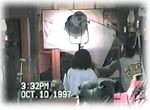|
|
|
Josef
Quinn Memorial Library
Shooting
the Episodes
By
Wolf Schneider
1996
With
the Western town set just two blocks away from the offices,
writers are often hurrying down the dusty road and across the
bridge, onto the four-acre set. Most of the action takes place
within a three-block radius.
 This
afternoon, like most afternoons, the horses are standing tranquilly
in the sun-light, loosely tied to hitching posts and slurping
from their water troughs. Inside the clinic, the cameras are
rolling as the Reverend is told he needs his tonsils removed.
The clinic's ivory lave curtains are tied aside to allow the
natural light to stream through - and to permit cinematographer
Ozzie Smith and director James Keach to film the action on the
street as well as in the clinic. This
afternoon, like most afternoons, the horses are standing tranquilly
in the sun-light, loosely tied to hitching posts and slurping
from their water troughs. Inside the clinic, the cameras are
rolling as the Reverend is told he needs his tonsils removed.
The clinic's ivory lave curtains are tied aside to allow the
natural light to stream through - and to permit cinematographer
Ozzie Smith and director James Keach to film the action on the
street as well as in the clinic.
"We're always shooting from the inside to the outside, since
the story's about a town and the people in the town," says Smith.
"I don't just let the outside exterior blow out and be dull.
I have a great deal of background going, plus the scene going
on inside. That's one of the keys to this show: something's
moving in that frame all the time."
Directors may come and go, but Smith is a constant. "If we're
inside the clinic or the general store," he advises them, "we
always try to stage the scene against a window so we can see
the town outside: the horses, the buggies, the costumes. I know
how much it costs for all that stuff. I figure, if the network's
gonna pay for it, we're gonna see it."
 Keeping
interiors and exteriors light-balanced and in focus is tricky.
The show is shot film-style, with two cameras usually operating;
there is also a heavy reliance on source lighting - which means
keying the light to sunlight, lanterns and other natural sources.
Shooting with 16 mm stock, Smith relies on 7245 and 7248 Eastman
Kodak film, the former with a 50 ASA for shooting during day-light,
and the latter with a 100 ASA for shooting night interiors and
exteriors. Keeping
interiors and exteriors light-balanced and in focus is tricky.
The show is shot film-style, with two cameras usually operating;
there is also a heavy reliance on source lighting - which means
keying the light to sunlight, lanterns and other natural sources.
Shooting with 16 mm stock, Smith relies on 7245 and 7248 Eastman
Kodak film, the former with a 50 ASA for shooting during day-light,
and the latter with a 100 ASA for shooting night interiors and
exteriors.
"The period look is all done with the lighting and the type
of film I use. That's the key. We use the low ASA film so we
can get the richness and the blacks and the depth, even during
the day," says Smith. He admits he had help from some far-thinking
individuals he never met: the folks who originally built this
Western town in 1927. "The way the town is set up from years
ago, for the major sets usually everything is backlit. So it
makes it a little easier."
|
|

